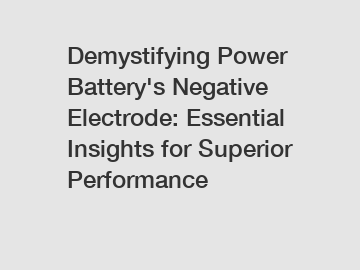Demystifying Power Battery's Negative Electrode: Essential Insights for Superior Performance
Demystifying Power Battery's Negative Electrode: Essential Insights for Superior Performance.
Today, power batteries play a vital role in our lives, serving as power sources for various devices and vehicles. The performance and longevity of these batteries depend on several factors, with the negative electrode being a crucial component that requires thorough understanding. In this article, we aim to demystify the negative electrode of a power battery, providing essential insights to achieve superior performance.
Composition of the Negative Electrode:

The negative electrode of a power battery is typically made up of a host material and an electrochemically active material. The host material, often graphite or silicon, provides structural support and acts as a host to store the active material. The electrochemically active material, commonly graphite, allows for reversible lithium intercalation and deintercalation during the battery's charge and discharge cycles.
Understanding Lithium Intercalation:
Lithium intercalation refers to the process of lithium ions moving into the host material's lattice structure during battery charging, while deintercalation occurs when the lithium ions move out of the host material during discharging. It is crucial to optimize this process to ensure efficient battery performance. Factors such as electrode composition, porosity, and particle size play a significant role in determining the intercalation and deintercalation efficiency.
Challenges of Silicon as an Active Material:
Silicon has gained attention as a potential replacement for graphite due to its superior lithium storage capacity. However, the use of silicon as an active material in the negative electrode presents challenges. During lithium intercalation, silicon undergoes a significant volume expansion, resulting in cracking and pulverization of the electrode. This phenomenon, known as the "silicon anode dilemma," reduces the battery's overall performance and cycle life.
Addressing the Silicon Anode Dilemma:
Researchers and battery manufacturers are actively working to overcome the challenges associated with silicon anodes. Various strategies, such as engineering nanostructured silicon, incorporating binders and conductive additives, and adopting composite electrode designs, have shown promising results. These approaches aim to mitigate the volume expansion issue, enhance structural integrity, and improve the overall performance of silicon-based negative electrodes.
Role of Solid Electrolyte Interphase (SEI):
The Solid Electrolyte Interphase (SEI) is a crucial component that forms on the negative electrode's surface during the initial charging process. It acts as a protective layer, preventing further reactions between the electrolyte and the electrode. A stable and well-formed SEI layer is essential for the long-term stability and durability of the battery. Researchers are actively studying SEI formation and exploring strategies to improve its quality and functionality.
Conclusion:
Understanding the negative electrode's intricacies is essential to achieve superior performance and longevity of power batteries. Factors such as electrode composition, intercalation efficiency, active materials, and the formation of the SEI layer all contribute to the overall battery performance. By addressing challenges associated with materials like silicon and optimizing intercalation processes, researchers and manufacturers continue to push the boundaries of battery technology.
For further insights into power battery technology or if you have any queries, please do not hesitate to contact us.
Keywords: contact us.
If you are looking for more details, kindly visit crucible for sale, high-quality Graphite crucibles sale, Customize graphite blocks.


